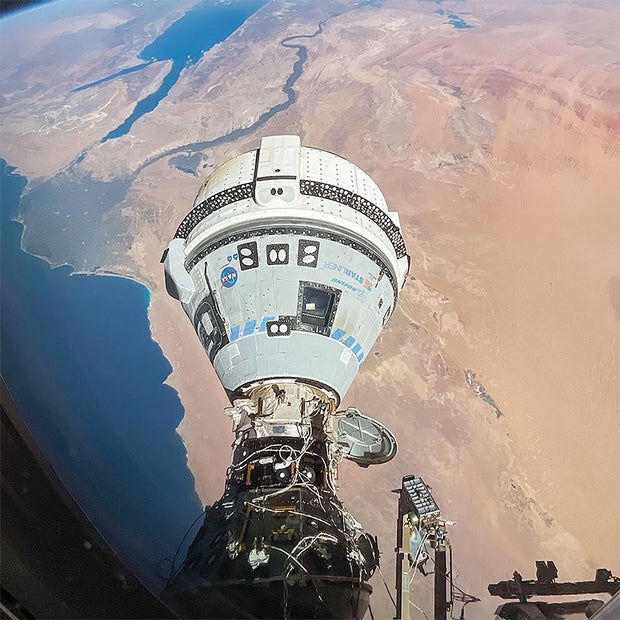A critical test was conducted this weekend to confirm Boeing Starliner capsule can bring safety the staff of two people returned to Earth despite problems that arose early in the mission, officials said Thursday.
Unexpected helium leak and thrusters maneuver degradation, found during ship rendezvous with the International Space Station in early June, triggering weeks of testing and analysis that have extended the ship’s first pilot test flight from more than a week to nearly two months.
Steve Stich, manager of NASA’s Commercial Crew Program, said Starliner commander Barry “Butch” Wilmore and co-pilot Sunita Williams, both veterans of previous space station visits, have taken the full mission very quickly and are enjoying their bonus time in orbit.
NASA
As for when they can leave to return to Earth, Stich told reporters “we don’t have a major announcement today relative to the return date. We’re making great progress, but we’re just not quite ready to do it.”
“Very important test” for Starliner
Two technical hurdles remain: tests this weekend for “hot fire” 27 maneuvering thrusters in the Starliner service module to ensure that they will work as expected between undocking and re-entry; and parallel testing to confirm five known helium leaks in the propulsion pressurization system has not worsened.
Pressurized helium is used to force propellant into the thrusters for ignition. The thrusters, in turn, are required to re-orient the Starliner as required after undocking and remain steady while the larger rocket fires to put the ship out of orbit for re-entry and landing.
“We will fire all the thrusters through several pulses, just to make sure before we undock, that all the systems perform the way we expected and the way it was the last time we checked,” said Stich. “We will also get a chance to see the helium system.
“It’s been six weeks since we last checked the helium system, which was June 15th. So we’ll pressurize the manifold by manifold, and then fire up the thrusters, then we’ll have a chance to see the helium leak rate. and verify that the system is stable.”
All in all, “it’s a very important test in the coming weekend,” he said.
Barring a major surprise, NASA’s flight readiness review will be conducted to outline the problem to senior management, along with a “flight rationale,” that is, an analysis that shows the problem is known and does not pose a credible safety threat.
“There is some important education about leadership going into this agency’s flight readiness review,” Stich said. “We have struggled to explain everything that has happened, and I apologize for that. This is a very complicated subject.”
The Starliner was launched on its first test flight on June 5. During the next rendezvous with the International Space Station, several helium leaks were detected – one known before launch – and the five aft-facing maneuvering thrusters failed to operate as the flight software expected. .
Four were then successfully tested and one was declared a failure.
Rear-facing drives are exposed to direct sunlight for long periods of time, so they can be used in higher than normal temperatures. That, coupled with the rapid fire sequence during the rendezvous, may have contributed to the observed performance.
To find out, Boeing took the flight thruster from another Starliner to NASA’s test facility in White Sands, New Mexico, and ran through two rendezvous sequences that mimic what the Starliner experienced in orbit along with five return to Earth, or “descent,” scenarios.
Similar thrust degradation was evident and when the engineers disassembled the test thruster, the Teflon seal was found to be slightly deformed, possibly due to exposure to one of the propellants, nitrogen tetroxide.
“The team … looked at the thrusters to see if the seals survived the flight,” Stich said. “If you look at what we did to that thruster, it shows that we can survive five feet down. So we made sure the seal was intact.”
As for the helium leak, Stich said the flight controller pressurized the system for previous tests in orbit and the leak is known not to be worse; all were within acceptable limits.
“We’re going to check this weekend for the helium leak scenario, and then before we open, we’re going to pressurize the system again and check for the helium leak. … We’re making sure everything is covered.”
When the Starliner flies, the battery is rated for 45 days in space. Based on actual performance in orbit, Stich said the limit has been extended to 90 days. Thursday marked the ship’s 50th day in space and Stich said Wilmore and Williams could return to Earth by the end of August.
“I’m very confident that we have a great vehicle to bring the crew back,” said Mark Nappi, Boeing’s Starliner program manager. “We need to take the next steps to share that information with others, and that will lead to an agency review, and that’s what we’re going to do over the next week.”





